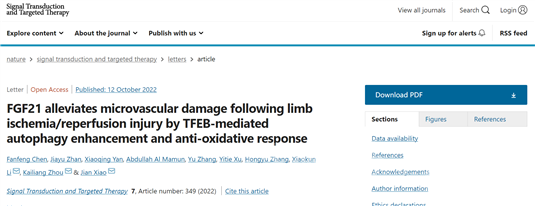- Academician Li Xiaokun’s team of School of Pharmaceutical Sciences Reports FGF21 Alleviating Acute Lower Limb Ischemia/Reperfusion Injury
- Author:Chen Fanfeng, School of Pharmaceutical Sciences Date:October 24, 2022
Restoring the blood flow to the ischemic limb as soon as possible is a requisite for the restoration of the normal function of an acute ischemic limb. However, the stress reaction after reperfusion may induce ischemia tissue injury, also known as Ischemia/Reperfusion injury (I/R injury), which is one of the main causes of mortality and disability in patients with acute lower limb ischemia. At present, many studies on pharmaceutical therapy for acute lower limb I/R injury do not work in clinical application. One of the reasons may be that most of the current studies only focus on skeletal muscle injury while ignoring microvascular injury.
Fibroblast growth factor (FGF) is a class of peptides with a wide range of biological activities. It is a pluripotent signaling molecule that participates in cell proliferation, differentiation, and migration. FGF21, a member of this family, plays a key role in regulating glucose and lipid homeostasis, thereby preventing the development of metabolic disorders such as obesity and diabetes. In recent years, FGF21 has also been found to be a stress hormone, which can induce adaptive stress response and regulate anti-oxidative response.
Recently, Academician Li Xiaokun's research group of the School of Pharmaceutical Sciences at Wenzhou Medical University published a paper online in Signal Transduction and Targeted Therapy entitled "FGF21 alleviates microvascular damage following limb ischemia/reperfusion injury by TFEB-mediated autophagy enhancement and anti-oxidative response", which revealed the role of FGF21 in acute lower limb I/R injury and its molecular mechanism. Chen Fanfeng, a PhD candidate at Wenzhou Medical University, is the first author, and Li Xiaokun, Xiao Jian and Zhou Kailiang are the corresponding authors.

The research group found that the expression of endogenous FGF21 was significantly up-regulated in the mouse model with acute hind limb I/R injury, and further elucidated that I/R injury-induced FGF21 up-regulation is an endogenous protective mechanism through FGF21 deficiency and administration. Compared with wild-type mice, skeletal muscle and microvascular injury caused by I/R injury further deteriorated in FGF21-KO mice. Administration of exogenous FGF21 effectively inhibited these negative effects caused by I/R injury. GO analyses of transcriptome sequencing results revealed that FGF21 alleviated I/R injury through the anti-oxidative response, autophagy enhancement, and anti-apoptotic effects. The inhibitor of Nuclear Factor, Erythroid 2 Like 2 (NFE2L2) reversed the anti-oxidative and anti-apoptosis effects of FGF21 on endothelial cells in vivo and in vitro. In addition, researchers applied the interfering RNA technique and found that silencing of transcription factor EB (TFEB) abolished the FGF21-induced autophagy restoration, anti-oxidative response, and anti-apoptotic effects. WB and immunofluorescence results showed that FGF21 enhanced the nuclear translocation of TFEB. Intriguingly, the study demonstrated that FGF21 modulated TFEB activation through the AMPK-MCOLN1-calcineurin pathway.

This study demonstrates for the first time that depletion of FGF21 aggravates limb hypoperfusion, microvascular injury, tissue edema, and skeletal muscle fiber damage after I/R injury, while replenishment of FGF21 effectively reverses the adverse effects. In addition, FGF21 enhances the nuclear translocation of TFEB by activating the AMPK-MCONL1-calcineurin signaling pathway. TFEB activation restores the autophagic flux in microvessels after I/R injury, improves lysosomal function, and enhances the NFE2L2-mediated anti-oxidative effects, which inhibit endothelial cell apoptosis, alleviate I/R-induced microvascular damage, and promote limb viability. This study indicates that FGF21 is an effective target for the treatment of microvascular limb I/R injury.
Article Link: https://www.nature.com/articles/s41392-022-01172-y
Text translated by Zeng Hai and reviewed by Sun You.
